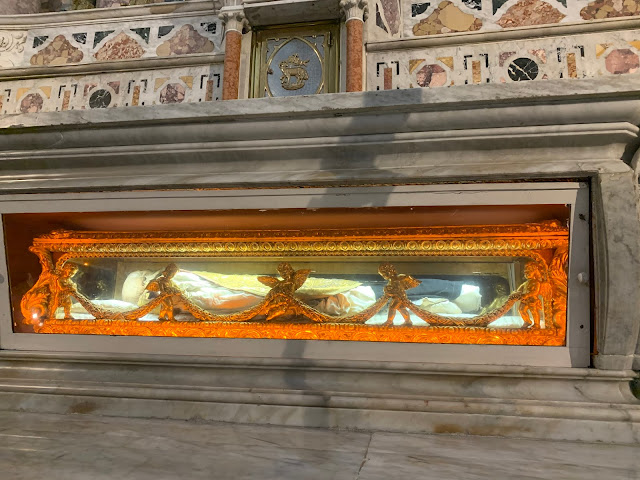Cartagena is Colombia's second oldest city and the only walled city in the Americas.
The walls were built to protect Cartagena from pirates.
We booked a TUI walking tour for Cartagena as we only had a day here but also for safety reasons and for convenience. Good decision!
The bus took us to the Old Town, a UNESCO World heritage site and our first stop was San Felipe Castle where we were immediately ambushed from all angles by street vendors who had everything from panama hats to tableclothes to brightly coloured dresses. They weren't rude but they were very persistent. We had had very strict instructions not to make eye contact, but I couldn't help looking at the gorgeous bright colours they were all wearing.
This huge fort stands on top of the Hill of San Lazaro and took the Spanish over 100 years to build, starting in 1536.
The statue in front of the castle is of a Spanish navy officer
with his one arm, one eye and one leg.
We were then taken to a little shopping mall where they were hoping we would part with some cash.
Naaaah.
It was an area full of colour and character, there were a lot of fabulously coloured football shirts and flags and bags and jewellery and all the other little nicknacks that you don't want to buy.
Door knockers hold great importance in Cartagena.
The size of the knocker denotes the status of the family behind it.
The bigger the knocker the more important the family.
The design of the knocker signifies the profession of the homeowner.
For example, turtles, fish, mermaids were on the doors of those who make their living from the sea, lions represent teachers, lizards represent royalty, masonic symbols represent builders and engineers, it was fun to be looking for them as we walked around the Old Town.
See how much attention I was paying!
Though I must admit, he was a very knowledgeable guide and I couldn't keep up with him, lol.
The Church of Santo Domingo
A 16th century convent which became a college and is now an institute of fine arts.
There is colour everywhere.
Brightly dressed ladies, intricately decorated doors, vibrant house decorations, beautiful plants and vines twining their way across house balconies and all these against a glorious blue sky, what a colourful place this is.
The Plaza de San Pedro Clava (Saint Peter Clava) was lovely and of particular interest were the sculptures made out of wrought-iron depicting Colombians carrying out their everyday life tasks. Obviously, I LOVE LOVE LOVED this little sewing lady.
The models are the work of Edgardo Carmona.
The Church of Saint Peter Clava
The church is one of several buildings that surround a beautiful courtyard.
These are quiet and reflective cloisters with huge trees that shade the well where Saint Peter baptized thousands of black slaves.
We walked through the museum with its fine art drawings and treasures commemorating the life of Saint Peter.
Nativity scene inside the church.
At the altar lie the remains of Saint Peter Claver who died in 1654 in Cartagena after devoting his life to evangelizing and to baptizing thousands of black slaves.
He was born in Spain and then studied to be a priest in Cartagena, living in Jesuit houses in Tunja and Bogota. While there, he was deeply disturbed by the harsh treatment of the black slaves who had been brought across from Africa. 10,000 slaves were brought in every year and conditions were so bad it is estimated a third lost their lives in transit.
Peter would meet and board the ships as they arrived, to treat and minister the terrified slaves, many of whom were starving and diseased due to the cramped and horrifying conditions. He provided medicine, food, brandy, lemons and tobacco in addition to spiritual consolation.
He personally baptized 300,000 slaves and over the years he checked up on them to ensure they were still being treated humanely.
His work was not exclusive to slaves. He preached to sailors and merchants in the square and was a frequent visitor to hospitals, preparing many (even criminals) for death.
After years of unremitting hard work and commitment by Peter, the slave situation began to improve and Peter became The Apostle of Cartagena.
He was canonised in 1888 and the church took his name. His remains lie at the altar.
Heading back to port.
Modern Cartagena from our coach window.
The Port Oasis Eco Park is located alongside the cruise ship terminal so we had a chance to see all the birds we didn't see in the rainforest yesterday.
(It's okay, I wasn't expecting to see a toucan, parrots, a peacock, flamingos or an anteater in the wild haha)
The anteater was HUGE.
I took this photo for my flamingo loving niece... and then I realised my tee (Christmas puddings!) matched the salmon colour of the flamingos...(eyes slightly improving...)
The galley crew had been busy while we were exploring Cartagena.
They'd made us a gingerbread village.













































No comments:
Post a Comment